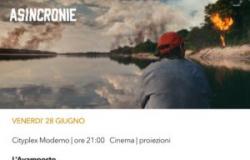Raffaele Pascale, researcher at INAF in Bologna and first author of the study on the mass of the black hole at the center of Leo I published in A&A Letters. Credits: Inaf
We talked about it three years ago, about the dwarf galaxy Leo I, and we called it “a little lion with a big heart”. According to the study published at the time by a team led by Maria Jose Bustamante-Rosell, of the University of Texas in Austin (USA), it was certainly not an exaggeration: the estimate of the mass of the black hole that Leo I hosts at the center was found to be be well 3.3 millions of solar masses. An enormous value, beyond any reasonable expectation: comparable to that of Sagittarius A* (4.4 million solar masses), the supermassive black hole of our galaxy, the Milky Way, which however has a mass approximately ten thousand times greater.
In short, a value that would make more than one astronomer jump in their seat. As happened to the four authors of a new study, published online last April on A&A Letters, according to which that estimate of 3.3 million solar masses must be drastically reduced: Leo I’s black hole, in the best case scenario, would not exceed hundreds of thousands of solar masses. Not supermassive, therefore, but intermediate. How did they get there? We asked the first author of the new study, Raffaele Pascale, 32 years old, originally from Satriano di Lucania, in Basilicata, now a researcher at INAF in Bologna. «It was more or less the beginning of last year», he recalls, «I was working with Alessandro Della Croce on another research on intermediate mass black holes, when Carlo Nipoti, who had been my doctoral tutor, forwarded me the studio of Maria Jose Bustamante”.
The one where they say that at the center of Leo I there is a supermassive black hole?
“Yes exactly. It was a truly anomalous result, I remember that Carlo, jokingly, called it “the black hole with the galaxy around it”, it seemed incredibly large compared to the galaxy that hosted it, a small satellite galaxy of the Milky Way. The topic interested us, we were working on intermediate mass black holes in globular clusters. So we decided to try to understand something more.”
You were a little wary, in short. How did you do it to understand more? Have you collected new data?
«No, we took the data at face value. So we got in touch with the first author of the article, Maria Jose Bustamante, and asked her directly to provide them to us. In fact, our idea was to try to analyze them with a different method.”
Did she get them for you?
«Yes, I wrote her an email explaining that we had read her article, that we were very interested in carrying out similar work and asking her, in fact, if she could make her data available to us. And she sent them to me within a few days: they were text files, files with spectroscopic data relating to the probability distribution of the speed of the stars in that region. So last summer we got to work.”
And what did you find?
«We obtained apparently very different results from theirs».
Very different? In what sense?
«First of all on the probability that that black hole actually exists: according to them, the possibility that Not is present is very unlikely. What we found, however, is that the probability that this black hole is not there is approximately the same as that of its being there. Then there is the estimate of the mass: they say that it is over a million solar masses, while in our opinion – if that black hole exists – its mass is not greater than a few hundred thousand solar masses. Much less massive, therefore, and much more in line both with the models of black hole formation and, above all, with what is expected to host this type of system. In other words: in our opinion, the peculiarity of this galaxy is that in reality it is not particular, it is a normal galaxy, like many others.”


Leo I (inset), a tiny satellite galaxy of the Milky Way (in the main image), has a black hole in its nucleus almost as massive as that of the Milky Way, but it is about 30 times larger. Credits: Esq/Gaia/Dpac; Sdss (box)
I understand that the method used is different, but how is it possible, starting from the same data, to arrive at such distant results?
«I think it all depends on how precise a measurement can be given a certain instrument. And we believe that the tool that we used is much more accurate, much more precise, than the one they used. I say “tool” in quotation marks: we are talking about methods of comparison between a particular type of models and observations. And so-called dynamic models based on distribution functions that depend on actions. That is, a method that is coupled with a type of comparison between data and models based on Bayesian statistics. Well, the methodology and models we used to describe the dynamics of these systems with black holes are, in our opinion, much more accurate – and also much more general – than the models and statistical method that was instead used by Bustamante’s team ».
What is the difference between your method and theirs?
«Well, let’s say that we have the possibility of “marginalizing on many degenerate parameters”, as they say in jargon: we can, for example, study possible dependencies of the mass of this black hole on what is called stellar anisotropy – that is, the velocity distribution of the stars present in the center of Leo I. This is because identical gravitational effects can have different causes.”
But what else could it be, if it is not a black hole, that leads to data like the ones collected?
“We are not saying that the black hole does not exist, we are not at the point of excluding its presence: we are placing a lower limit on its maximum mass.”
What will the next step be? Collect new data?
“Well, we certainly expect the Bustamante team to come out with new data.”
Do you think they will give them to you again? After you used the previous ones to demolish the result?
«I would say yes, on the other hand we have always been very honest and very correct towards them. We also consulted the author of the article before submitting ours for publication, for example. We didn’t take the liberty of doing things secretly: we asked for an opinion first, and there was continuous correspondence even during the writing of our article. So I imagine that we will see some new data soon, they will probably publish something based on this data, and at that point we will evaluate. In short, the question is still open. Let’s say that there is a second voice, which is ours, whereas before that didn’t even exist.”


The four authors of the new study on the mass of the black hole at the center of Leo I. From left: Raffaele Pascale, Carlo Nipoti, Alessandro Della Croce and Francesco Calura. Credits: Inaf
Isn’t this strange? I mean, theirs is such an anomalous result that I imagined there would be a race to dismantle it…
«Well, I don’t know. Let’s keep in mind that their article came out at the end of 2021, not that long ago. I don’t know if there is any other group that is working on the same thing. On the other hand, the greatest difficulty is having the data, unless you have a proprietary instrument available, or in any case one with a certain number of guaranteed observation hours. The advantage of Bustamante’s team is that they had access to a spectrograph, even if not entirely proprietary, still for internal use – I believe – of the University of Texas”
Is this why you don’t collect other data on your own?
«Yes, and also because all of us, authors of this article, work on the theoretical side. Simply, although we obviously know how to make a request to obtain observation time, and we have partly done so, none of us are experts in the observation sector.”
Don’t get your hands dirty…
«But no, it’s not about getting your hands dirty… Let’s say we’ve never thought about it. Maybe we will do so in the future, given that there is certainly the possibility of improvement based on more precise data, that’s for sure.”
And in any case Bustamamte will provide you with the data.
«Yes, he told us that they are waiting for them, this new data, and he also mentioned promising results – promising results. However, we don’t know if and when they will be published.”
To know more:








